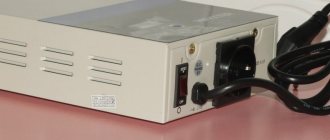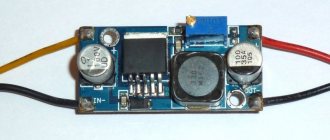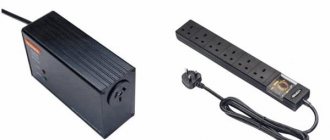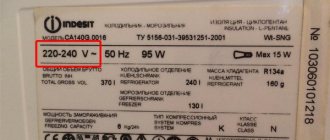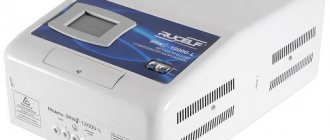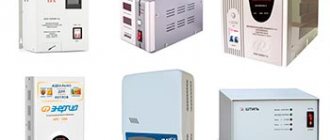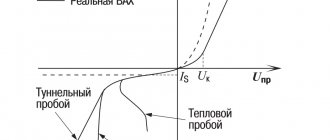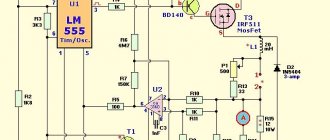A stabilizer is a device that is an electrical device that is used to equalize network voltage fluctuations when supplying current to equipment such as computers, air conditioners, pumps, etc.
Why do you need a voltage stabilizer? The regulator is mainly intended:
- protect electrical equipment from various threats such as voltage fluctuations, high and low voltage;
- disconnect equipment from poor-quality power supply when voltage thresholds increase or decrease;
- maintain voltage at the proper level.
This device has many unique features that allow you to save energy, influence productivity and increase the reliability of equipment. The main parameters of the electrical network are displayed on the device’s display; being always aware of them means being in control of the situation. The turn-on delay function provides a respite and stabilizes the power before being supplied to the load, therefore increasing the service life of the devices.
And yet, why do you need a stabilizer? Its use represents the most affordable and effective measure of energy conservation, preservation of appliances from failure and peace of mind for household members.
Some tips for choosing a stabilizer
If the device is chosen correctly, then you can always rely on it and trust it. If you don’t really understand technology, you can rely on the seller’s suggestions and advice on choosing a voltage stabilizer. A professional will recommend to start:
- determine the power, type of stabilizer and operating voltage range;
- identify and analyze the problem: increased, decreased or abruptly changing voltage in the power supply network.
Based on the data received, then proceed to select a device.
How to correctly calculate the power of the device? Ideally, you need to determine which is the most powerful consumer in the power supply circuit. Let’s say the electrical receivers are a pumping station with a power of 1.5 kW, a sauna with a power of 10 kW, plus some other device with high energy consumption. All values in kilowatts must be added up to obtain the required power of the device.
The stabilizer is selected with a small power reserve (20%), especially if the circuit contains equipment with a large starting current. We are talking about electric motors and pumps, which, when starting, consume more energy than in normal mode.
The power reserve ensures a long life of the device, thanks to the gentle operating mode, and creates reserve potential for connecting new equipment.
When choosing a stabilizer, you also need to take into account service, because the device should be connected correctly and efficiently, as well as take advantage of the warranty period and be repaired in case of malfunction.
Selection rules
Before deciding on the choice of a stabilizer based on the type of power supply, it is important to decide in which networks it is intended to be used. If you plan to use it in an apartment in a city house, the owner will need a standard single-phase device. If the buyer intends to use it at the dacha, where there is a 380 Volt power supply, only a three-phase sample will do.
Before going to the store, it is important to familiarize yourself with the manufacturers of these devices and choose a company that has a good reputation. In this case, it does not matter whether it is a domestic or foreign company, since our manufacturers are also capable of making competitive models.
How to choose the right voltage stabilizer for your home?
You can use the simplest option: determine the power consumption from the network based on the rating of the input circuit breaker in the apartment panel. In this way, the throughput of the machine and the maximum possible power consumption for household needs are determined.
Let's give a simple example. How to choose a 220 V voltage stabilizer for your home if there is an S40 machine at the input. With such a rated current, you can get no more than 10 kW from the network. Based on the calculated data, the device is selected.
Today, low voltage in the network is a very pressing problem and the best way to solve it is to purchase a stabilizer that will protect all equipment in the house from failure. To choose the right device, you first need to understand its varieties, as well as the advantages of each design option.
What it is
An anti-roll bar is part of almost any type of suspension. It looks like an inconspicuous pipe, but it is responsible for traffic safety, car control and comfort in the cabin.
This does not have to be direct labor . Its shape can be quite bizarre. This is due to the layout of the chassis and the decoration of the engine compartment of the car. Its smooth lines go around the components and assemblies. It must connect the two parts of the machine in the transverse direction. Roughly speaking, it connects the left and right elements of the car’s suspension.
The anti-roll bar is made of spring steel, the same material from which springs and leaf springs are made. It has sufficient elasticity and is capable of bending around its axis.
That is, if you take it by the opposite ends (shoulders) and twist them, it will twist. Of course, it is difficult to do this with your hands, but the mass of the machine will be enough for this.
Types of protective devices
The most popular types of stabilizers today are:
- electronic,
- electromechanical.
Electronic voltage stabilizers are devices of the best quality. Due to the absence of mechanical parts, they are characterized by a long service life, at least 15 years, and fairly high reliability. Can be selected according to the operating voltage range for almost any task.
Electromechanical voltage stabilizers are characterized by low operating speed, a narrow voltage range, but good overload capacity.
Types of stabilizers and their areas of application
Today, several types of stabilizers are sold on the electrical market, among which are devices operating on the basis of an autotransformer and products based on transformerless double energy conversion technology. Let's look at the features and capabilities of each type of product.
| Stabilizer type | Scheme of work | Stabilization features |
| Autotransformer | These devices include relay, electromechanical, thyristor and triac voltage stabilizers. The products have a similar principle of voltage correction, which is performed by a switching unit (depending on the type of stabilizer, it can be a relay, mechanical drive or electronic keys), switching to the winding of the autotransformer that is capable of providing the output voltage as close as possible to the nominal value. | The more windings an autotransformer has, the smoother and more accurate the voltage regulation is. On average, for such devices the voltage deviation from the nominal value ranges from 2 to 10%. However, such accuracy may not be sufficient for particularly electrically sensitive types of loads. The response to network fluctuations occurs with a slight delay (from 5 ms), which is why the device output may experience increased or decreased voltage. Another disadvantage of autotransformer models is the lack of network distortion correction. |
| Double conversion | These stabilizers include inverter models, which are considered new generation devices. They do not have an autotransformer and switching blocks. Their voltage correction is performed through double electronic conversion: the input alternating voltage is first rectified into direct voltage, and then, using an inverter, it is converted back into alternating voltage, but with reference characteristics. | These stabilizers are capable of adjusting the input voltage instantly (in 0 ms) during network fluctuations in a fairly wide range (90-310 V). At the same time, the output signal has high accuracy: its deviation from the nominal value is no more than 2%. The products are guaranteed to provide the load with ideal sinusoidal voltage, regardless of network distortion. Inverter models are so far the only stabilizers that ensure uninterrupted operation of the load during short-term network outages (up to 200 ms). |
The scope of use of stabilizers is determined by their technical capabilities. Autotransformer stabilizers are used mainly to protect electrical equipment that does not require power quality, for example, lighting devices, television equipment, kitchen appliances and power tools without electric motors. Inverter models, due to their high characteristics, are suitable for protecting any type of load and are used in the most unstable electrical networks.
Useful information about voltage stabilizers regarding high accuracy
Many people try to choose a device with maximum stabilization accuracy, up to 0.5%. However, as a rule, a deviation of 10–15 V is considered normal operation for most equipment. And only in rare cases does the equipment fail to work or become capricious due to such deviations. Most of the stabilizers offered on the market provide exactly this mode of operation.
A common misconception among buyers is that the purchased device with high stabilization accuracy is a guarantee of stable voltage and no flickering of light. In fact, it turns out the other way around: the greater the accuracy of the device, the more often it switches, adapting to the input network, which is why the light bulbs do not stop flickering. This applies to incandescent and halogen lamps.
When installing a triac and relay type stabilizer, the flickering of the light bulbs will be completely preserved. The only exceptions are stabilizers with smooth signal adjustment. This applies to new developments of stabilizers such as Voltaire. When choosing a regulator, it is advisable to follow the recommendations from the manufacturer or professionals. To be sure, you can also read positive and negative reviews on the Internet for a specific model or brand.
The principle of operation of the stabilizer:
A stabilizer is essentially a transformer to the windings of which “any” voltage is supplied and 220 volts are removed. The lower the input voltage, the more windings the stabilizer turns on.
Suppose there are 10 windings in the stabilizer, for the period while the current in the incoming network is 220 volts, it does not work, as soon as the power drops to 200 it turns on one winding and thereby maintains 220 volts at the output, the power drops to 180, the stabilizer connects another winding ( second) and still the output is 220 and so on. I will not write about the types of stabilizers (especially from the last century), besides, the only difference is in the principle of switching the windings.
At the moment, there are two main switching principles: relay and diode. The first differs from the second in slow operation, lack of smooth switching and low cost. Low cost plays a significant role here.
Price order (February 2013): a 5 kW relay type stabilizer costs about 6-10 thousand rubles, a diode type - 25-35 thousand rubles.
What does the switching principle affect:
- The response time from the moment the input decreases to the switching, both in terms of issuing a command to switch the windings, and the time required for the switching device to operate (for example, clicking a relay)
- Step - how much the voltage must drop for the stabilizer to turn on the next winding (relay - 3-12 volts, diode - 1.5-8 volts)
As is clear from the above, the question can only be reduced to smoothness, since the diode operates quickly, the step is small and the switching speed is instantaneous, unlike the relay, which is more thoughtful and will click the relay causing changes.
So, to summarize: the best stabilizer is the one that has a minimum response time, switches quickly and in small steps.
Additionally: a slight flickering of the light may be observed on the relay stabilizer. The relay stabilizer is not suitable for installing an inverter; the inverter will not tolerate this.
Which one to choose: single-phase or three-phase?
If three phases are installed in the house, it is not at all necessary to install a three-phase stabilizer. Most often, it turns out, you can get by with single-phase ones. In this case, you can get a lot of benefits.
Firstly, at cost, which in total for three single-phase ones is less than for three-phase ones. Secondly, in terms of maintainability it is more reliable. It’s one thing to remove one unit and take it for repairs, another thing to remove the entire device.
Purpose
This part in the suspension of absolutely any car allows you to reduce lateral body roll when turning the car.
In short, this device protects the car from tipping over .
This element is installed on most modern cars. It is thanks to the SPU that the car is stable, maneuverable and controllable.
The main task of the SPU is to redistribute the load between the elastic parts in the suspension when moving. When the car turns, the body rolls. Roll greatly influences the trajectory along which the car will move. At this very moment the stabilizer comes into operation.
Commercial benefits from installing a voltage stabilizer
Domestic power grids are physically very worn out, and in some places they are morally outdated. And there are more and more consumers. Installing stabilizers is beneficial for several reasons:
- Modern technology is equipped with electronic components, which require high-quality nutrition. To ensure that it does not fail or undergo expensive repairs, it is necessary to install a stabilizer;
- Lower voltage entails greater current consumption from the network. You have to pay more for energy consumption. The benefit of the stabilizer is obvious;
- Increased voltage can lead to short circuits, overheating of wires and fire. Without a stabilizer in this case, material and moral damage can be colossal, or even irreparable;
- at normal voltage, sudden impulses from lightning, personnel errors, and phase imbalance during rush hour can also occur.
In all these and other unforeseen cases, a voltage stabilizer will help save time, money and nerves.
How does it work
The principle of operation of the anti-roll bar is to link opposite wheels of the same axle. When the position of one wheel relative to the body changes, it tries to bring the opposite wheel into the same position, aligning the body.
When the car rolls to one side, the distance between the wheel and the body decreases. One edge of the stabilizer rises through the stand. It unscrews and, due to its elasticity, lifts the other wheel relative to the body. Since it is rigidly connected by the central part to the car body through bushings, the body lowers, reducing the distance of the opposite wheel relative to the car. This way the body is leveled in a horizontal position.
In simple terms, thanks to the anti-roll bar, the body resists roll . It is impossible to completely avoid them. That is, it can compensate for small inclinations, but not large ones.
If this threshold is exceeded, it may break. Replacing the anti-roll bar will protect the car from overturning and discomfort while driving.
To prevent this from happening, the design includes rubber elastic elements. They are made in the form of silent blocks and bushings on the racks and places of attachment to the body. Thanks to them, not all kinematics from one wheel are transmitted to the other. We have a connection between the wheels, but it is not rigid, the structure “plays” and dampens. In addition, they soften the impacts of moving elements, so you don’t hear knocking while driving.
Video about the principle of operation of the stabilizer
Let's summarize
Valuable qualities of the regulators are the device's quick response to changes in parameters in the network, an extended operating voltage range, good overload capacity, a sine wave of the correct shape at the output, and noiselessness.
But no matter how much is said about the merits of a particular brand, the most priority characteristic for the consumer always remains the ratio of price and quality. Therefore, the golden mean will undoubtedly be the choice of high-quality domestic products.
why do you need a voltage stabilizer?
Installation and connection features
As a rule, connecting stabilizers is not difficult, especially network and main single-phase ones. Network regulators are connected to a regular home network outlet. Their body has the same sockets (one, two or more, depending on the power), to which you can connect any household-level device.
Trunk stabilizers are connected using a 5-pin terminal block. Two - for power supply wires, two - for entering the home network and one for grounding (required). When installing the stabilizer near the point where the cable line enters the house, you can connect it yourself. But in this case, the main circuit breaker (switch) should be turned off. Making connections under voltage is extremely dangerous and is unacceptable according to all safety regulations.
Install a stabilizer of any power after the electric meter. The three-phase stabilizer is equipped with a block with nine terminals. It must be connected by a professional electrician using special tools. Stabilizers are installed on the wall or on the floor, depending on the power and design option.
As a rule, their operation is permitted only at positive temperatures and normal humidity. At T ≥ +40 0C, the thermal protection of the device may work, so the stabilizer should be installed away from heating devices in places protected from direct sunlight.
If you notice an error, a non-working video or link, please select a piece of text and press Ctrl+Enter .
0
